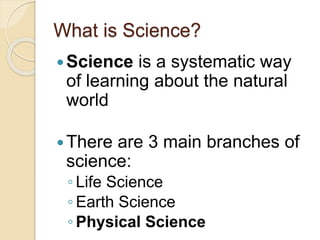Intro to Physical Science (Grade 8: Class B ONLY)
•Transferir como PPTX, PDF•
11 gostaram•8,339 visualizações
Powerpoint for Class "B" to study. CLASS "A" YOU DO NOT NEED TO STUDY THIS!
Denunciar
Compartilhar
Denunciar
Compartilhar

Recomendados
Mais conteúdo relacionado
Mais procurados
Mais procurados (20)
Physical Science Chapter 1.1 What is Physical Science?

Physical Science Chapter 1.1 What is Physical Science?
Introduction to Science 3.1 : Exploring Physical Science

Introduction to Science 3.1 : Exploring Physical Science
Destaque
Destaque (8)
Physical Science Notes - Properties, Systems, Matter & Energy

Physical Science Notes - Properties, Systems, Matter & Energy
Mga batayang kasanayan sa pagbasa at pagsusuri ng mga Uri ng teksto

Mga batayang kasanayan sa pagbasa at pagsusuri ng mga Uri ng teksto
Etikal na pananaliksik at mga responsibilidad ng mananaliksik 

Etikal na pananaliksik at mga responsibilidad ng mananaliksik
Semelhante a Intro to Physical Science (Grade 8: Class B ONLY)
Semelhante a Intro to Physical Science (Grade 8: Class B ONLY) (20)
Último
Último (20)
HMCS Max Bernays Pre-Deployment Brief (May 2024).pptx

HMCS Max Bernays Pre-Deployment Brief (May 2024).pptx
On National Teacher Day, meet the 2024-25 Kenan Fellows

On National Teacher Day, meet the 2024-25 Kenan Fellows
Jual Obat Aborsi Hongkong ( Asli No.1 ) 085657271886 Obat Penggugur Kandungan...

Jual Obat Aborsi Hongkong ( Asli No.1 ) 085657271886 Obat Penggugur Kandungan...
UGC NET Paper 1 Mathematical Reasoning & Aptitude.pdf

UGC NET Paper 1 Mathematical Reasoning & Aptitude.pdf
Kodo Millet PPT made by Ghanshyam bairwa college of Agriculture kumher bhara...

Kodo Millet PPT made by Ghanshyam bairwa college of Agriculture kumher bhara...
ICT Role in 21st Century Education & its Challenges.pptx

ICT Role in 21st Century Education & its Challenges.pptx
Plant propagation: Sexual and Asexual propapagation.pptx

Plant propagation: Sexual and Asexual propapagation.pptx
Intro to Physical Science (Grade 8: Class B ONLY)
- 1. What is Science? Science is a systematic way of learning about the natural world There are 3 main branches of science: ◦ Life Science ◦ Earth Science ◦ Physical Science
- 2. What is Physical Science? Physical Science is the study of matter and energy, and the changes they undergo ◦ Matter is anything that has mass and takes up space Mass = the amount of matter an object contains ◦ Energy is the ability to do work Physical science has two branches: ◦ Chemistry ◦ Physics
- 3. What is Physical Science? Chemistry = the study of the properties of matter and the changes they undergo Physics = the study of matter and energy and how they interact
- 4. How Scientists Think… They use skills of observation to learn more about the natural world.
- 5. Observation Observing = using one or more senses to gather information Two Types: ◦Quantitative observation ◦ Qualitative observation
- 6. Quantitative observations use numbers ◦ Example: measuring your height or weight Qualitative observations describe what you see; don’t involve numbers ◦ Example: Noticing that a ball is round or that it is raining outside
- 7. Look at this animal speed chart: What are some observations you can make?
- 8. The Scientific Method Definition: ◦ A logical, stepwise approach used by scientists to find answers to questions. Steps: ◦ 1. Observation: Observations are made by scientists about their surrounding environment. The observations allow scientists to ask questions. ◦ 2. State the Problem: The problem statement is in the form of a question. It is derived from the observations made by the scientist.
- 9. The Scientific Method ◦ 3. Form a Hypothesis: A hypothesis (an educated guess) is a possible explanation for the observation or problem. A hypothesis must be tested to determine its validity. ◦ 4. Conduct an Experiment: An experiment tests your hypothesis. ◦ 5. Analyze Data: Data (information gathered from the experiment) must be accurately recorded. Data can be displayed in a graph, chart, or table.
- 10. How to Display Data Graph Chart
- 11. How to Display Data Table
- 12. The Scientific Method ◦ 6. Form a Conclusion: Based upon the experimental results, conclusions can be made about the validity, or correctness, of your hypothesis. After many experiments that give the same results, a scientific theory may be formed.
- 13. The Scientific Method A scientific theory is a well-tested, verified hypothesis that fits existing data and explains how natural processes or events are thought to occur. It is a basis for predicting future events or discoveries. Theories may be modified as new information is gained. (Think back to your puzzle activity!)